Law, Rights and Social Justice: A Comparative Study of Two Nations
VerifiedAdded on 2020/04/21
|10
|2180
|41
Essay
AI Summary
This essay undertakes a comparative analysis of the legal frameworks concerning human rights in the United States and Australia. It begins by outlining the historical context of international human rights legislation, referencing the Universal Declaration of Human Rights and its influence. The essay then explores the commitment of both nations to upholding human rights, despite the absence of national Human Rights Charters in both countries. It examines the specific legal mechanisms and policies in place in the USA, including the Constitution, Bill of Rights, and Supreme Court decisions, and the challenges faced in ensuring human rights, such as those related to women's protection and political manipulation. Similarly, it explores the Australian human rights landscape, focusing on the role of the Australian Human Rights Commission, relevant legislation, and the influence of the Magna Carta. The essay concludes by highlighting the key differences and similarities in the approaches of the two countries, including the reliance on common law and legislative changes in Australia and the absence of ratification of certain international conventions in the USA.

Running head: LAW, RIGHTS AND SOCIAL JUSTICE
Law, Rights and Social Justice
Name of the Student
Name of the University
Author Note
Law, Rights and Social Justice
Name of the Student
Name of the University
Author Note
Paraphrase This Document
Need a fresh take? Get an instant paraphrase of this document with our AI Paraphraser
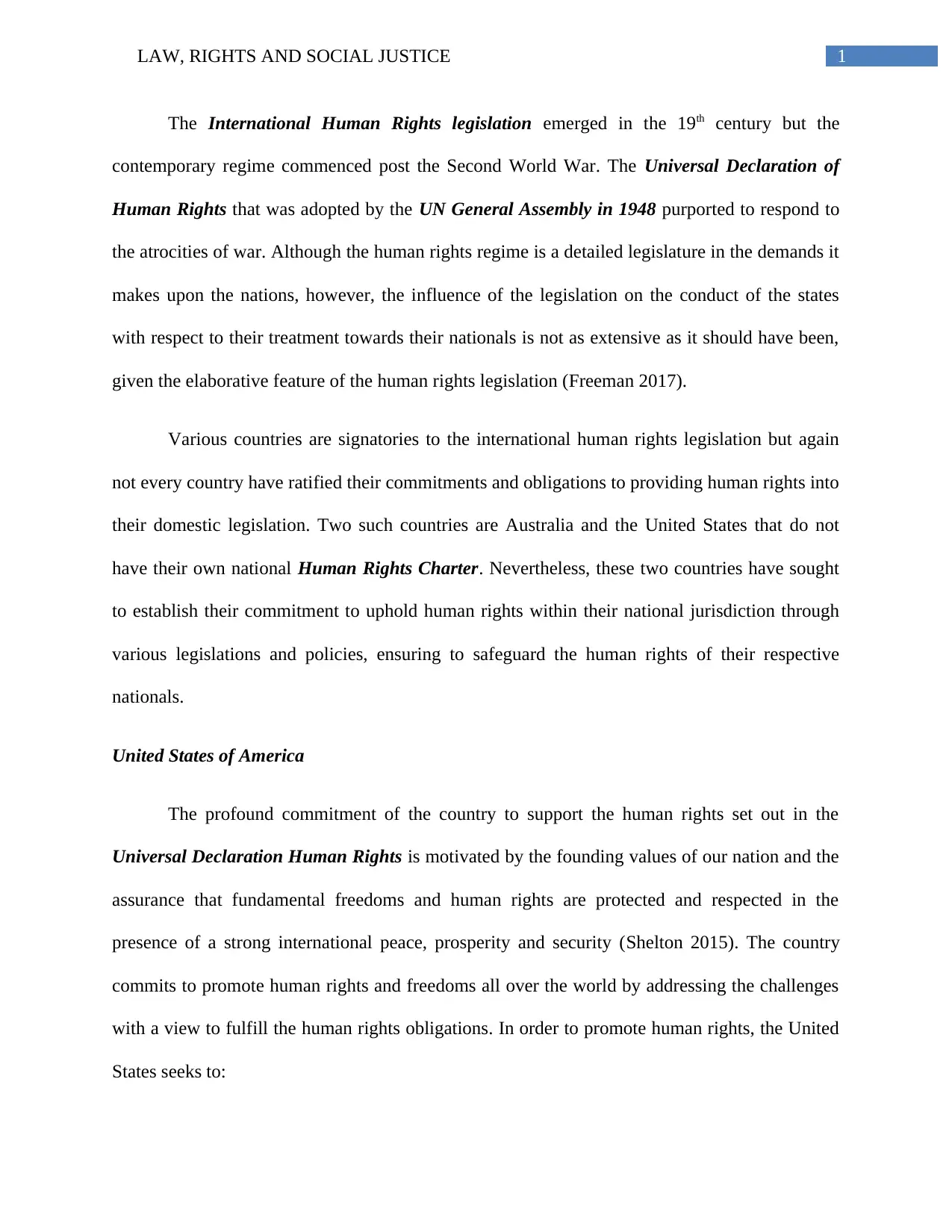
1LAW, RIGHTS AND SOCIAL JUSTICE
The International Human Rights legislation emerged in the 19th century but the
contemporary regime commenced post the Second World War. The Universal Declaration of
Human Rights that was adopted by the UN General Assembly in 1948 purported to respond to
the atrocities of war. Although the human rights regime is a detailed legislature in the demands it
makes upon the nations, however, the influence of the legislation on the conduct of the states
with respect to their treatment towards their nationals is not as extensive as it should have been,
given the elaborative feature of the human rights legislation (Freeman 2017).
Various countries are signatories to the international human rights legislation but again
not every country have ratified their commitments and obligations to providing human rights into
their domestic legislation. Two such countries are Australia and the United States that do not
have their own national Human Rights Charter. Nevertheless, these two countries have sought
to establish their commitment to uphold human rights within their national jurisdiction through
various legislations and policies, ensuring to safeguard the human rights of their respective
nationals.
United States of America
The profound commitment of the country to support the human rights set out in the
Universal Declaration Human Rights is motivated by the founding values of our nation and the
assurance that fundamental freedoms and human rights are protected and respected in the
presence of a strong international peace, prosperity and security (Shelton 2015). The country
commits to promote human rights and freedoms all over the world by addressing the challenges
with a view to fulfill the human rights obligations. In order to promote human rights, the United
States seeks to:
The International Human Rights legislation emerged in the 19th century but the
contemporary regime commenced post the Second World War. The Universal Declaration of
Human Rights that was adopted by the UN General Assembly in 1948 purported to respond to
the atrocities of war. Although the human rights regime is a detailed legislature in the demands it
makes upon the nations, however, the influence of the legislation on the conduct of the states
with respect to their treatment towards their nationals is not as extensive as it should have been,
given the elaborative feature of the human rights legislation (Freeman 2017).
Various countries are signatories to the international human rights legislation but again
not every country have ratified their commitments and obligations to providing human rights into
their domestic legislation. Two such countries are Australia and the United States that do not
have their own national Human Rights Charter. Nevertheless, these two countries have sought
to establish their commitment to uphold human rights within their national jurisdiction through
various legislations and policies, ensuring to safeguard the human rights of their respective
nationals.
United States of America
The profound commitment of the country to support the human rights set out in the
Universal Declaration Human Rights is motivated by the founding values of our nation and the
assurance that fundamental freedoms and human rights are protected and respected in the
presence of a strong international peace, prosperity and security (Shelton 2015). The country
commits to promote human rights and freedoms all over the world by addressing the challenges
with a view to fulfill the human rights obligations. In order to promote human rights, the United
States seeks to:

2LAW, RIGHTS AND SOCIAL JUSTICE
Hold governments responsible for their obligations stipulated under the UDHR norms
and international human rights instruments;
Promotes the rule of law, change cultures of impunity and look for accountability;
Coordinates human rights activities with important associates including regional
organizations and EU;
Although, international human rights law provides an essential framework for ensuring the
rights of all people in every countries but human rights standards does not become enforceable in
the United States unless and until they are implemented through state, local and/or federal law.
International treaties define the rights in general context and the international courts and the
monitoring procedure lacks ability to make their decisions become enforceable in the United
States. Since the utmost capacity for protection lies in the context of domestic law, hence, one of
the most appropriate ways to improve the human rights in the United States is to strengthen
domestic legal protections for human rights (Smith 2016). The domestic legislations shall pass
laws that recognizes such rights and ensure the implementation of such human rights by the US
courts and US government assuring such laws are consistent with international standards.
In the USA, the USA, the Constitution, and the Bill of Rights sets out broad human rights
protections. Several rights that are stipulated in the Constitution of the country are in compliance
with as well as equivalent to some of the rights stipulated in the UDHR, in particular, to the
political and civil liberties. In addition, the US Supreme Court has identified such fundamental
rights that are not stipulated in the Constitution such as presumption of innocence in freedom of
movement and in a criminal trial.
Hold governments responsible for their obligations stipulated under the UDHR norms
and international human rights instruments;
Promotes the rule of law, change cultures of impunity and look for accountability;
Coordinates human rights activities with important associates including regional
organizations and EU;
Although, international human rights law provides an essential framework for ensuring the
rights of all people in every countries but human rights standards does not become enforceable in
the United States unless and until they are implemented through state, local and/or federal law.
International treaties define the rights in general context and the international courts and the
monitoring procedure lacks ability to make their decisions become enforceable in the United
States. Since the utmost capacity for protection lies in the context of domestic law, hence, one of
the most appropriate ways to improve the human rights in the United States is to strengthen
domestic legal protections for human rights (Smith 2016). The domestic legislations shall pass
laws that recognizes such rights and ensure the implementation of such human rights by the US
courts and US government assuring such laws are consistent with international standards.
In the USA, the USA, the Constitution, and the Bill of Rights sets out broad human rights
protections. Several rights that are stipulated in the Constitution of the country are in compliance
with as well as equivalent to some of the rights stipulated in the UDHR, in particular, to the
political and civil liberties. In addition, the US Supreme Court has identified such fundamental
rights that are not stipulated in the Constitution such as presumption of innocence in freedom of
movement and in a criminal trial.
⊘ This is a preview!⊘
Do you want full access?
Subscribe today to unlock all pages.

Trusted by 1+ million students worldwide
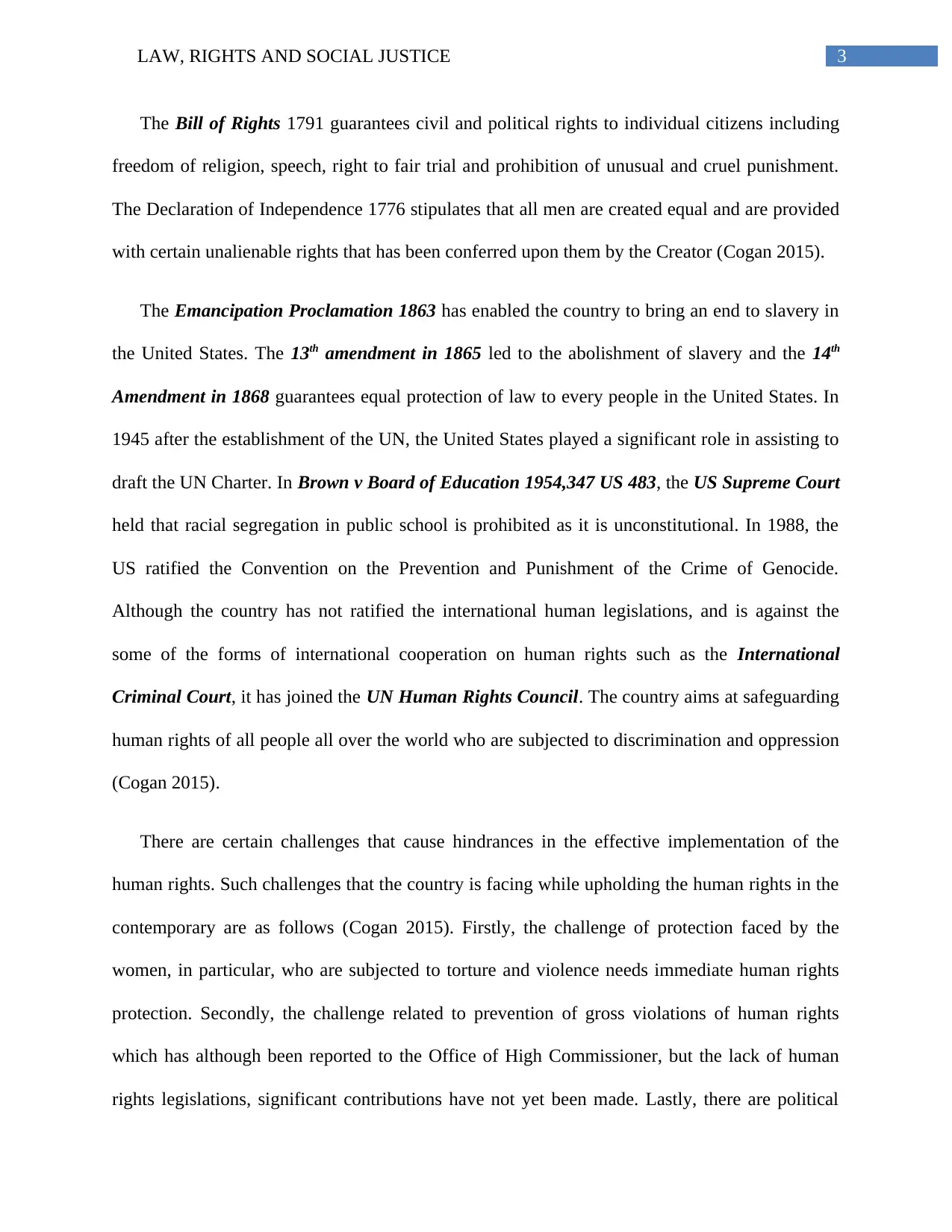
3LAW, RIGHTS AND SOCIAL JUSTICE
The Bill of Rights 1791 guarantees civil and political rights to individual citizens including
freedom of religion, speech, right to fair trial and prohibition of unusual and cruel punishment.
The Declaration of Independence 1776 stipulates that all men are created equal and are provided
with certain unalienable rights that has been conferred upon them by the Creator (Cogan 2015).
The Emancipation Proclamation 1863 has enabled the country to bring an end to slavery in
the United States. The 13th amendment in 1865 led to the abolishment of slavery and the 14th
Amendment in 1868 guarantees equal protection of law to every people in the United States. In
1945 after the establishment of the UN, the United States played a significant role in assisting to
draft the UN Charter. In Brown v Board of Education 1954,347 US 483, the US Supreme Court
held that racial segregation in public school is prohibited as it is unconstitutional. In 1988, the
US ratified the Convention on the Prevention and Punishment of the Crime of Genocide.
Although the country has not ratified the international human legislations, and is against the
some of the forms of international cooperation on human rights such as the International
Criminal Court, it has joined the UN Human Rights Council. The country aims at safeguarding
human rights of all people all over the world who are subjected to discrimination and oppression
(Cogan 2015).
There are certain challenges that cause hindrances in the effective implementation of the
human rights. Such challenges that the country is facing while upholding the human rights in the
contemporary are as follows (Cogan 2015). Firstly, the challenge of protection faced by the
women, in particular, who are subjected to torture and violence needs immediate human rights
protection. Secondly, the challenge related to prevention of gross violations of human rights
which has although been reported to the Office of High Commissioner, but the lack of human
rights legislations, significant contributions have not yet been made. Lastly, there are political
The Bill of Rights 1791 guarantees civil and political rights to individual citizens including
freedom of religion, speech, right to fair trial and prohibition of unusual and cruel punishment.
The Declaration of Independence 1776 stipulates that all men are created equal and are provided
with certain unalienable rights that has been conferred upon them by the Creator (Cogan 2015).
The Emancipation Proclamation 1863 has enabled the country to bring an end to slavery in
the United States. The 13th amendment in 1865 led to the abolishment of slavery and the 14th
Amendment in 1868 guarantees equal protection of law to every people in the United States. In
1945 after the establishment of the UN, the United States played a significant role in assisting to
draft the UN Charter. In Brown v Board of Education 1954,347 US 483, the US Supreme Court
held that racial segregation in public school is prohibited as it is unconstitutional. In 1988, the
US ratified the Convention on the Prevention and Punishment of the Crime of Genocide.
Although the country has not ratified the international human legislations, and is against the
some of the forms of international cooperation on human rights such as the International
Criminal Court, it has joined the UN Human Rights Council. The country aims at safeguarding
human rights of all people all over the world who are subjected to discrimination and oppression
(Cogan 2015).
There are certain challenges that cause hindrances in the effective implementation of the
human rights. Such challenges that the country is facing while upholding the human rights in the
contemporary are as follows (Cogan 2015). Firstly, the challenge of protection faced by the
women, in particular, who are subjected to torture and violence needs immediate human rights
protection. Secondly, the challenge related to prevention of gross violations of human rights
which has although been reported to the Office of High Commissioner, but the lack of human
rights legislations, significant contributions have not yet been made. Lastly, there are political
Paraphrase This Document
Need a fresh take? Get an instant paraphrase of this document with our AI Paraphraser
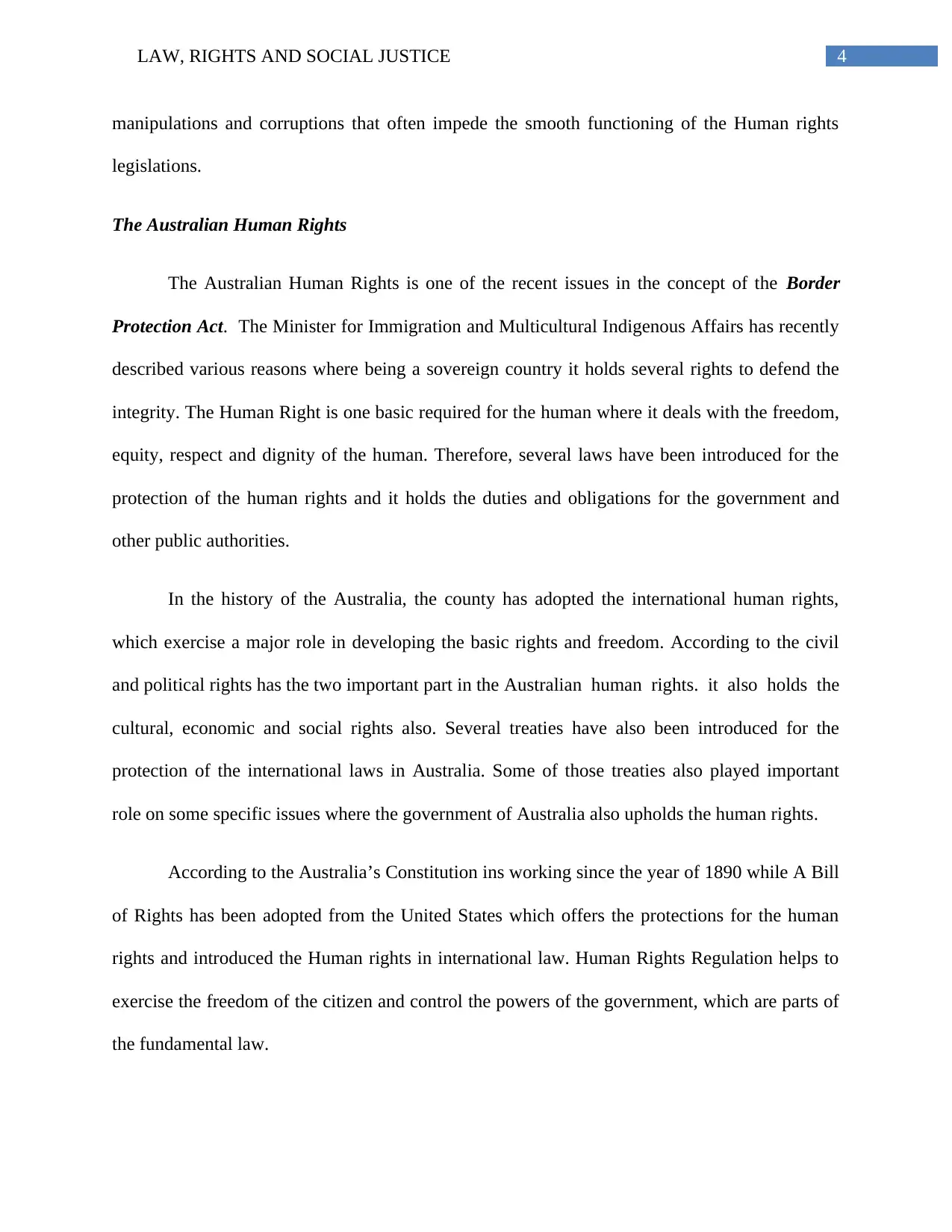
4LAW, RIGHTS AND SOCIAL JUSTICE
manipulations and corruptions that often impede the smooth functioning of the Human rights
legislations.
The Australian Human Rights
The Australian Human Rights is one of the recent issues in the concept of the Border
Protection Act. The Minister for Immigration and Multicultural Indigenous Affairs has recently
described various reasons where being a sovereign country it holds several rights to defend the
integrity. The Human Right is one basic required for the human where it deals with the freedom,
equity, respect and dignity of the human. Therefore, several laws have been introduced for the
protection of the human rights and it holds the duties and obligations for the government and
other public authorities.
In the history of the Australia, the county has adopted the international human rights,
which exercise a major role in developing the basic rights and freedom. According to the civil
and political rights has the two important part in the Australian human rights. it also holds the
cultural, economic and social rights also. Several treaties have also been introduced for the
protection of the international laws in Australia. Some of those treaties also played important
role on some specific issues where the government of Australia also upholds the human rights.
According to the Australia’s Constitution ins working since the year of 1890 while A Bill
of Rights has been adopted from the United States which offers the protections for the human
rights and introduced the Human rights in international law. Human Rights Regulation helps to
exercise the freedom of the citizen and control the powers of the government, which are parts of
the fundamental law.
manipulations and corruptions that often impede the smooth functioning of the Human rights
legislations.
The Australian Human Rights
The Australian Human Rights is one of the recent issues in the concept of the Border
Protection Act. The Minister for Immigration and Multicultural Indigenous Affairs has recently
described various reasons where being a sovereign country it holds several rights to defend the
integrity. The Human Right is one basic required for the human where it deals with the freedom,
equity, respect and dignity of the human. Therefore, several laws have been introduced for the
protection of the human rights and it holds the duties and obligations for the government and
other public authorities.
In the history of the Australia, the county has adopted the international human rights,
which exercise a major role in developing the basic rights and freedom. According to the civil
and political rights has the two important part in the Australian human rights. it also holds the
cultural, economic and social rights also. Several treaties have also been introduced for the
protection of the international laws in Australia. Some of those treaties also played important
role on some specific issues where the government of Australia also upholds the human rights.
According to the Australia’s Constitution ins working since the year of 1890 while A Bill
of Rights has been adopted from the United States which offers the protections for the human
rights and introduced the Human rights in international law. Human Rights Regulation helps to
exercise the freedom of the citizen and control the powers of the government, which are parts of
the fundamental law.
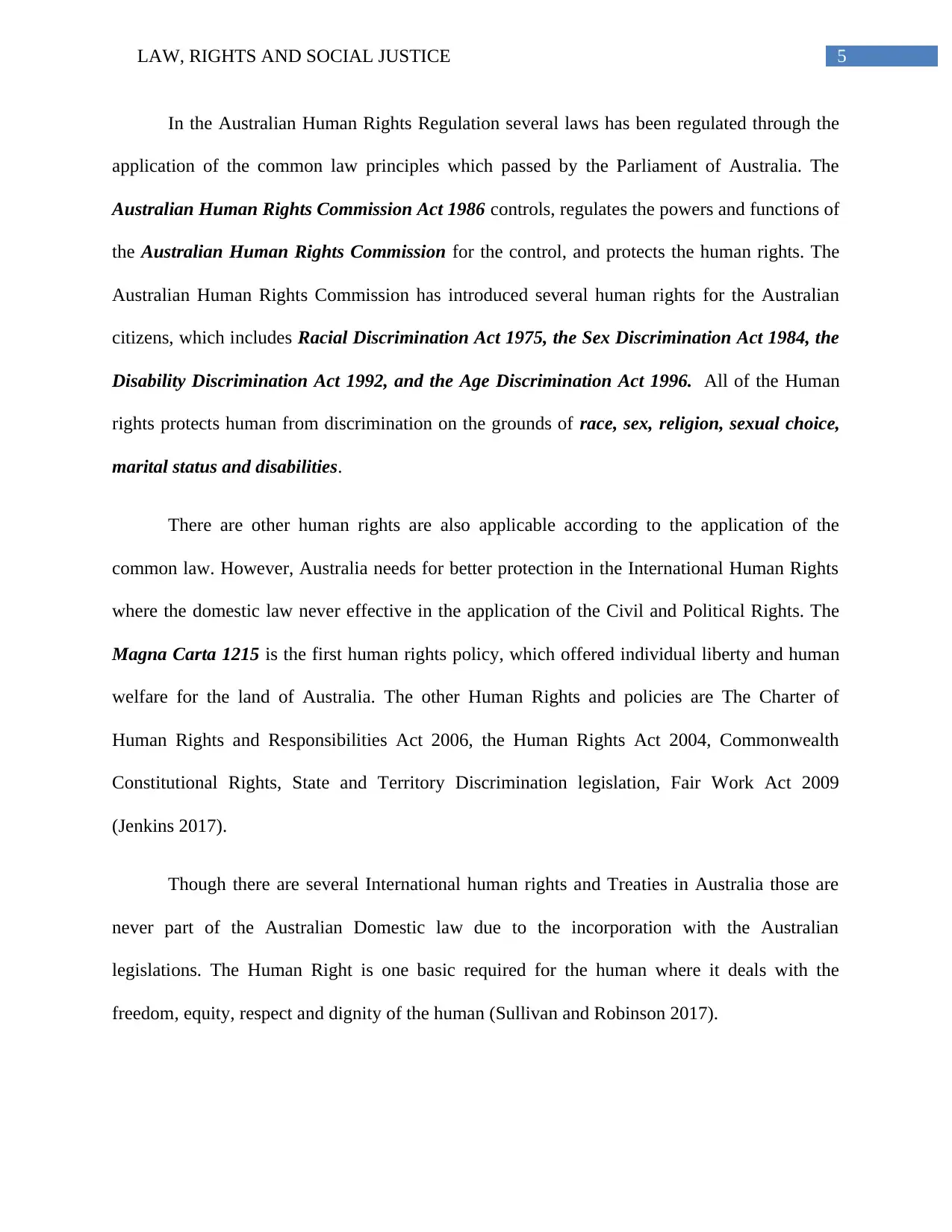
5LAW, RIGHTS AND SOCIAL JUSTICE
In the Australian Human Rights Regulation several laws has been regulated through the
application of the common law principles which passed by the Parliament of Australia. The
Australian Human Rights Commission Act 1986 controls, regulates the powers and functions of
the Australian Human Rights Commission for the control, and protects the human rights. The
Australian Human Rights Commission has introduced several human rights for the Australian
citizens, which includes Racial Discrimination Act 1975, the Sex Discrimination Act 1984, the
Disability Discrimination Act 1992, and the Age Discrimination Act 1996. All of the Human
rights protects human from discrimination on the grounds of race, sex, religion, sexual choice,
marital status and disabilities.
There are other human rights are also applicable according to the application of the
common law. However, Australia needs for better protection in the International Human Rights
where the domestic law never effective in the application of the Civil and Political Rights. The
Magna Carta 1215 is the first human rights policy, which offered individual liberty and human
welfare for the land of Australia. The other Human Rights and policies are The Charter of
Human Rights and Responsibilities Act 2006, the Human Rights Act 2004, Commonwealth
Constitutional Rights, State and Territory Discrimination legislation, Fair Work Act 2009
(Jenkins 2017).
Though there are several International human rights and Treaties in Australia those are
never part of the Australian Domestic law due to the incorporation with the Australian
legislations. The Human Right is one basic required for the human where it deals with the
freedom, equity, respect and dignity of the human (Sullivan and Robinson 2017).
In the Australian Human Rights Regulation several laws has been regulated through the
application of the common law principles which passed by the Parliament of Australia. The
Australian Human Rights Commission Act 1986 controls, regulates the powers and functions of
the Australian Human Rights Commission for the control, and protects the human rights. The
Australian Human Rights Commission has introduced several human rights for the Australian
citizens, which includes Racial Discrimination Act 1975, the Sex Discrimination Act 1984, the
Disability Discrimination Act 1992, and the Age Discrimination Act 1996. All of the Human
rights protects human from discrimination on the grounds of race, sex, religion, sexual choice,
marital status and disabilities.
There are other human rights are also applicable according to the application of the
common law. However, Australia needs for better protection in the International Human Rights
where the domestic law never effective in the application of the Civil and Political Rights. The
Magna Carta 1215 is the first human rights policy, which offered individual liberty and human
welfare for the land of Australia. The other Human Rights and policies are The Charter of
Human Rights and Responsibilities Act 2006, the Human Rights Act 2004, Commonwealth
Constitutional Rights, State and Territory Discrimination legislation, Fair Work Act 2009
(Jenkins 2017).
Though there are several International human rights and Treaties in Australia those are
never part of the Australian Domestic law due to the incorporation with the Australian
legislations. The Human Right is one basic required for the human where it deals with the
freedom, equity, respect and dignity of the human (Sullivan and Robinson 2017).
⊘ This is a preview!⊘
Do you want full access?
Subscribe today to unlock all pages.

Trusted by 1+ million students worldwide
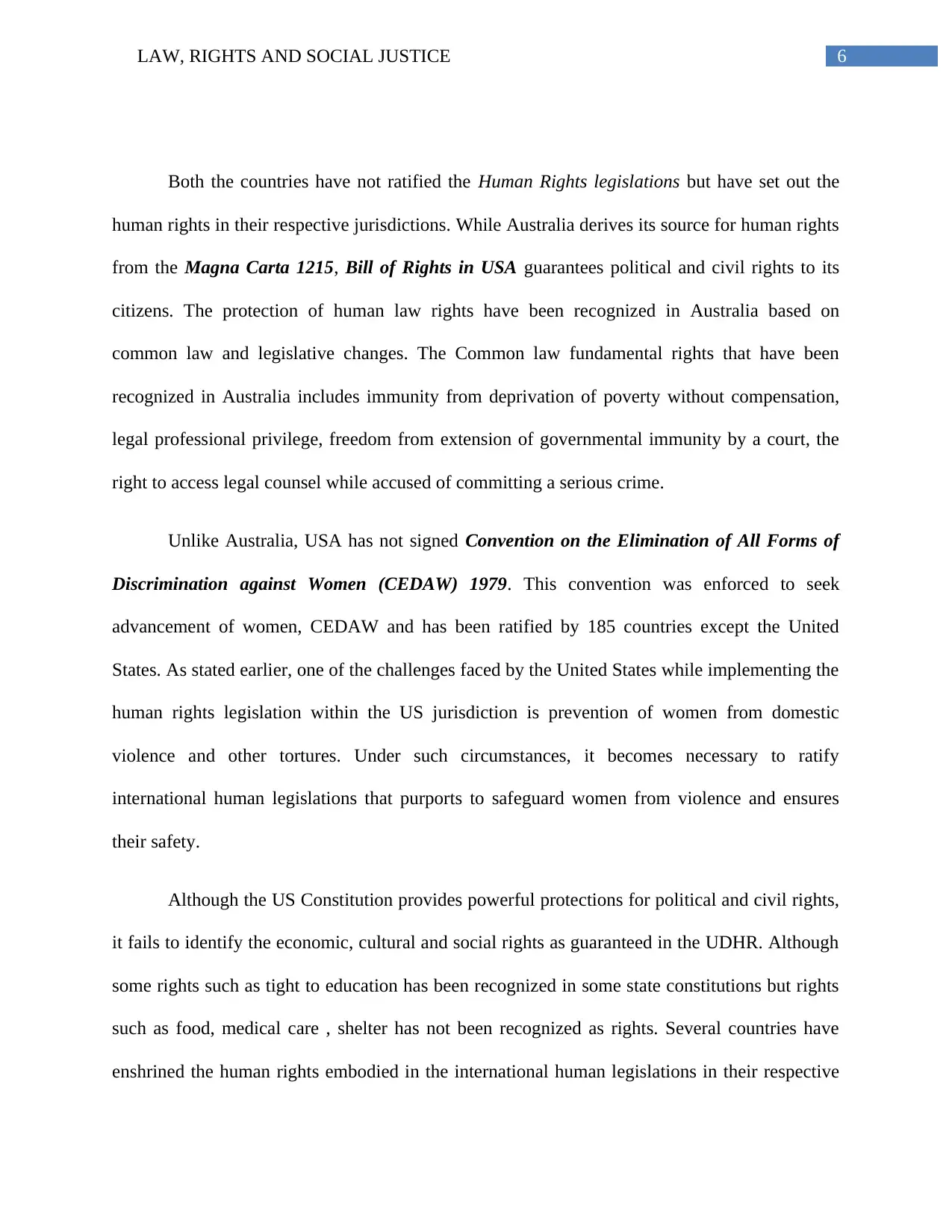
6LAW, RIGHTS AND SOCIAL JUSTICE
Both the countries have not ratified the Human Rights legislations but have set out the
human rights in their respective jurisdictions. While Australia derives its source for human rights
from the Magna Carta 1215, Bill of Rights in USA guarantees political and civil rights to its
citizens. The protection of human law rights have been recognized in Australia based on
common law and legislative changes. The Common law fundamental rights that have been
recognized in Australia includes immunity from deprivation of poverty without compensation,
legal professional privilege, freedom from extension of governmental immunity by a court, the
right to access legal counsel while accused of committing a serious crime.
Unlike Australia, USA has not signed Convention on the Elimination of All Forms of
Discrimination against Women (CEDAW) 1979. This convention was enforced to seek
advancement of women, CEDAW and has been ratified by 185 countries except the United
States. As stated earlier, one of the challenges faced by the United States while implementing the
human rights legislation within the US jurisdiction is prevention of women from domestic
violence and other tortures. Under such circumstances, it becomes necessary to ratify
international human legislations that purports to safeguard women from violence and ensures
their safety.
Although the US Constitution provides powerful protections for political and civil rights,
it fails to identify the economic, cultural and social rights as guaranteed in the UDHR. Although
some rights such as tight to education has been recognized in some state constitutions but rights
such as food, medical care , shelter has not been recognized as rights. Several countries have
enshrined the human rights embodied in the international human legislations in their respective
Both the countries have not ratified the Human Rights legislations but have set out the
human rights in their respective jurisdictions. While Australia derives its source for human rights
from the Magna Carta 1215, Bill of Rights in USA guarantees political and civil rights to its
citizens. The protection of human law rights have been recognized in Australia based on
common law and legislative changes. The Common law fundamental rights that have been
recognized in Australia includes immunity from deprivation of poverty without compensation,
legal professional privilege, freedom from extension of governmental immunity by a court, the
right to access legal counsel while accused of committing a serious crime.
Unlike Australia, USA has not signed Convention on the Elimination of All Forms of
Discrimination against Women (CEDAW) 1979. This convention was enforced to seek
advancement of women, CEDAW and has been ratified by 185 countries except the United
States. As stated earlier, one of the challenges faced by the United States while implementing the
human rights legislation within the US jurisdiction is prevention of women from domestic
violence and other tortures. Under such circumstances, it becomes necessary to ratify
international human legislations that purports to safeguard women from violence and ensures
their safety.
Although the US Constitution provides powerful protections for political and civil rights,
it fails to identify the economic, cultural and social rights as guaranteed in the UDHR. Although
some rights such as tight to education has been recognized in some state constitutions but rights
such as food, medical care , shelter has not been recognized as rights. Several countries have
enshrined the human rights embodied in the international human legislations in their respective
Paraphrase This Document
Need a fresh take? Get an instant paraphrase of this document with our AI Paraphraser
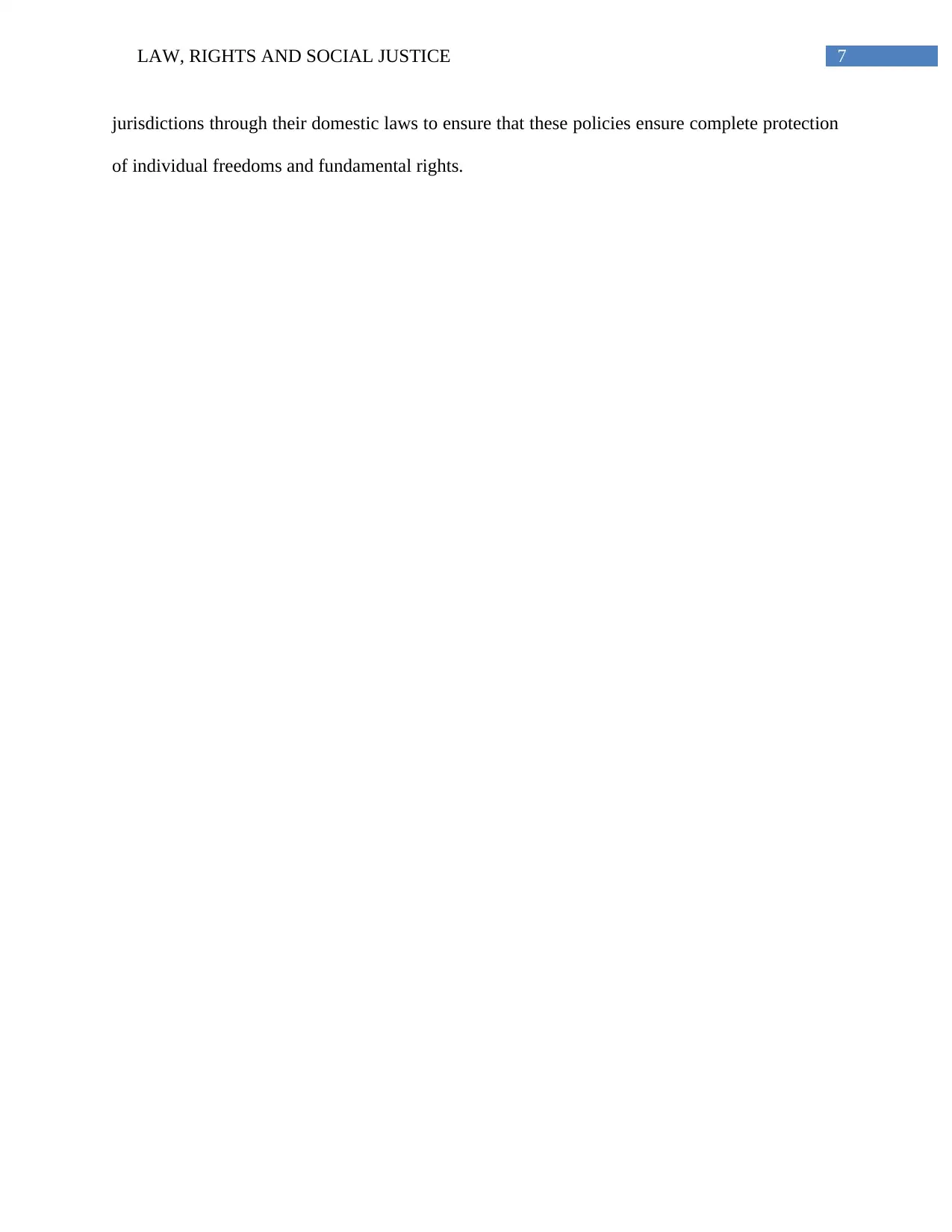
7LAW, RIGHTS AND SOCIAL JUSTICE
jurisdictions through their domestic laws to ensure that these policies ensure complete protection
of individual freedoms and fundamental rights.
jurisdictions through their domestic laws to ensure that these policies ensure complete protection
of individual freedoms and fundamental rights.
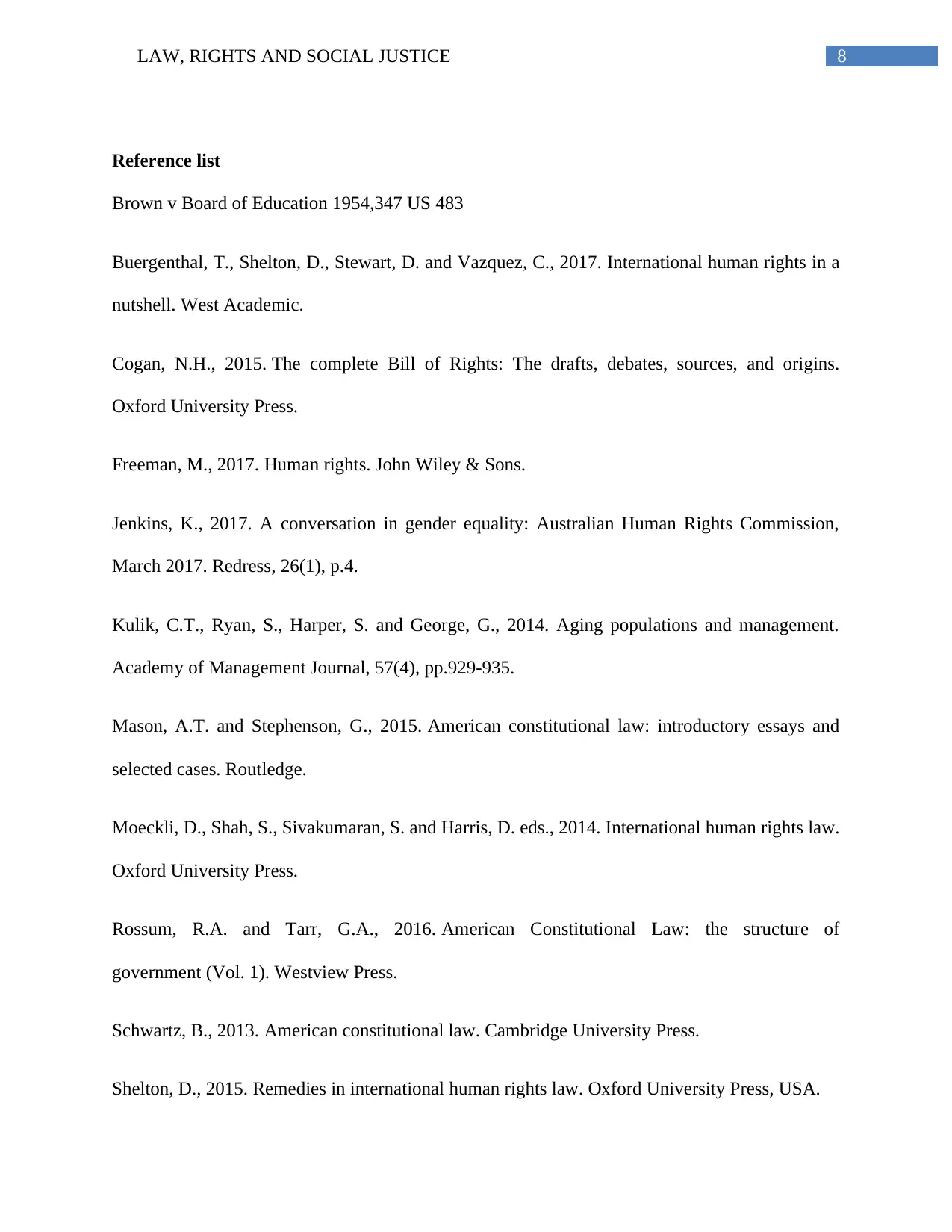
8LAW, RIGHTS AND SOCIAL JUSTICE
Reference list
Brown v Board of Education 1954,347 US 483
Buergenthal, T., Shelton, D., Stewart, D. and Vazquez, C., 2017. International human rights in a
nutshell. West Academic.
Cogan, N.H., 2015. The complete Bill of Rights: The drafts, debates, sources, and origins.
Oxford University Press.
Freeman, M., 2017. Human rights. John Wiley & Sons.
Jenkins, K., 2017. A conversation in gender equality: Australian Human Rights Commission,
March 2017. Redress, 26(1), p.4.
Kulik, C.T., Ryan, S., Harper, S. and George, G., 2014. Aging populations and management.
Academy of Management Journal, 57(4), pp.929-935.
Mason, A.T. and Stephenson, G., 2015. American constitutional law: introductory essays and
selected cases. Routledge.
Moeckli, D., Shah, S., Sivakumaran, S. and Harris, D. eds., 2014. International human rights law.
Oxford University Press.
Rossum, R.A. and Tarr, G.A., 2016. American Constitutional Law: the structure of
government (Vol. 1). Westview Press.
Schwartz, B., 2013. American constitutional law. Cambridge University Press.
Shelton, D., 2015. Remedies in international human rights law. Oxford University Press, USA.
Reference list
Brown v Board of Education 1954,347 US 483
Buergenthal, T., Shelton, D., Stewart, D. and Vazquez, C., 2017. International human rights in a
nutshell. West Academic.
Cogan, N.H., 2015. The complete Bill of Rights: The drafts, debates, sources, and origins.
Oxford University Press.
Freeman, M., 2017. Human rights. John Wiley & Sons.
Jenkins, K., 2017. A conversation in gender equality: Australian Human Rights Commission,
March 2017. Redress, 26(1), p.4.
Kulik, C.T., Ryan, S., Harper, S. and George, G., 2014. Aging populations and management.
Academy of Management Journal, 57(4), pp.929-935.
Mason, A.T. and Stephenson, G., 2015. American constitutional law: introductory essays and
selected cases. Routledge.
Moeckli, D., Shah, S., Sivakumaran, S. and Harris, D. eds., 2014. International human rights law.
Oxford University Press.
Rossum, R.A. and Tarr, G.A., 2016. American Constitutional Law: the structure of
government (Vol. 1). Westview Press.
Schwartz, B., 2013. American constitutional law. Cambridge University Press.
Shelton, D., 2015. Remedies in international human rights law. Oxford University Press, USA.
⊘ This is a preview!⊘
Do you want full access?
Subscribe today to unlock all pages.

Trusted by 1+ million students worldwide
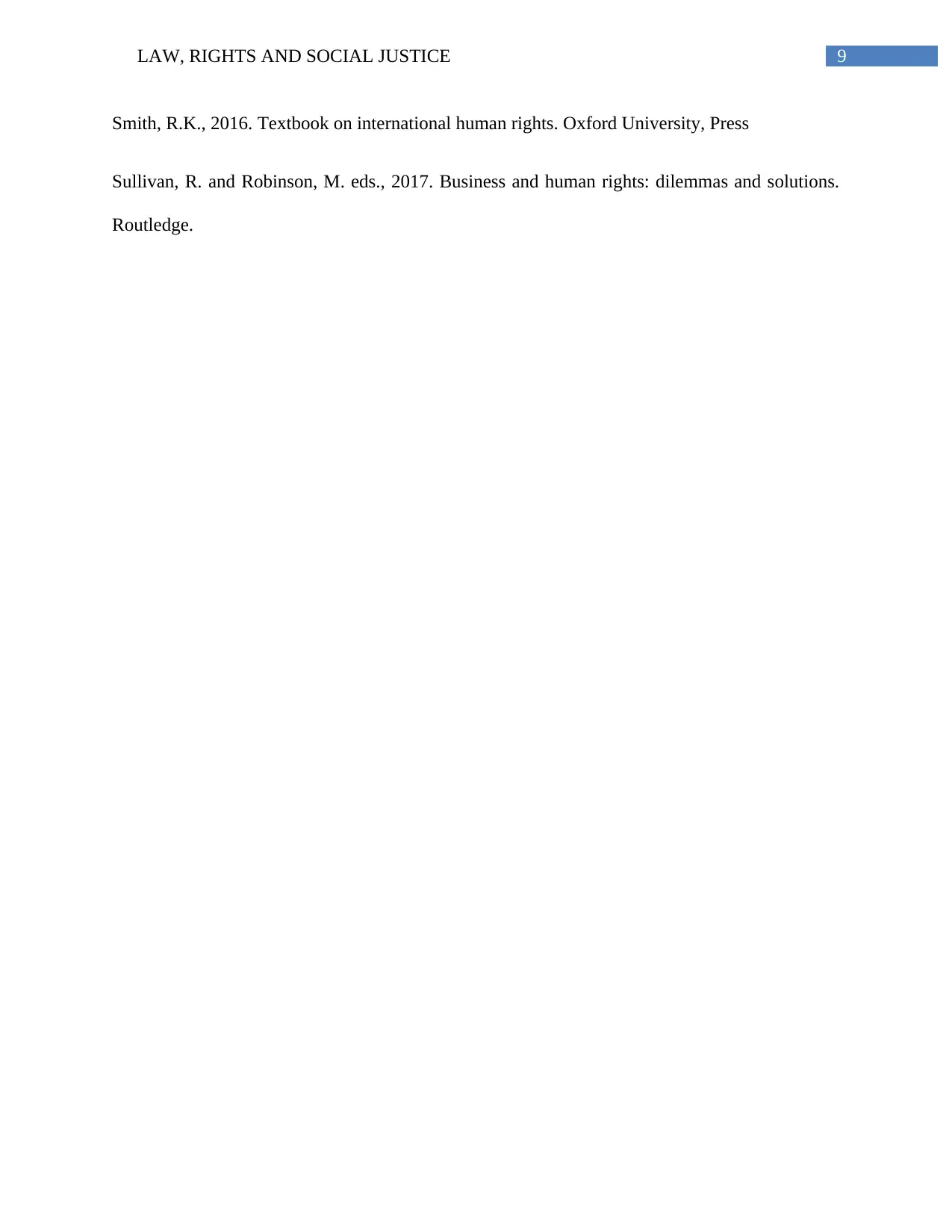
9LAW, RIGHTS AND SOCIAL JUSTICE
Smith, R.K., 2016. Textbook on international human rights. Oxford University, Press
Sullivan, R. and Robinson, M. eds., 2017. Business and human rights: dilemmas and solutions.
Routledge.
Smith, R.K., 2016. Textbook on international human rights. Oxford University, Press
Sullivan, R. and Robinson, M. eds., 2017. Business and human rights: dilemmas and solutions.
Routledge.
1 out of 10
Related Documents
Your All-in-One AI-Powered Toolkit for Academic Success.
+13062052269
info@desklib.com
Available 24*7 on WhatsApp / Email
![[object Object]](/_next/static/media/star-bottom.7253800d.svg)
Unlock your academic potential
Copyright © 2020–2025 A2Z Services. All Rights Reserved. Developed and managed by ZUCOL.





